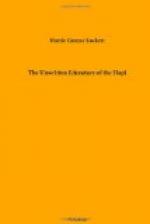Stability, then, lies in the plot rather than in the culture setting; the former may be ancient, while the latter sometimes reflects contemporary life.
Boaz[15] argues that much may be learned of contemporary tribal culture by a study of the mythology of a given people, since so much of the setting of the ancient tale reflects the tribal life of the time of the recording. He has made a test of the idea in his study of the Tsimshian Indians. From this collection of 104 tales he concludes that: “In the tales of a people those incidents of the everyday life that are of importance to them will appear either incidentally or as the basis of a plot. Most of the reference to the mode of life of the people will be an accurate reflection of their habits. The development of the plot of the story, further-more, will on the whole exhibit clearly what is considered right and what wrong.”
[Footnote 15: Boaz, Franz, Tsimshian Mythology: Bureau American Ethnology, vol. 35, 1916, p. 393.]
=How and Why Myths Are Kept=
There are set times and seasons for story-telling among the various Indian tribes, but the winter season, when there is likely to be most leisure and most need of fireside entertainment, is a general favorite. However, some tribes have myths that “can not be told in summer, others only at night, etc."[16] Furthermore there are secret cults and ceremonials rigidly excluding women and children, whose basic myths are naturally restricted in their circulation, but in the main the body of tribal myth is for the pleasure and profit of all.
[Footnote 16: Wissler, Clark, Op. cit., p. 256.]
Old people relate the stories to the children, not only because they enjoy telling them and the children like listening to them, but because of the feeling that every member of the tribe should know them as a part of his education.
While all adults are supposed to know something of the tribal stories, not all are expected to be good story-tellers. Story-telling is a gift, we know, and primitives know this too, so that everywhere we have pointed out a few individuals who are the best story-tellers, usually an old man, sometimes an old woman, and occasionally, as the writer has seen it, a young man of some dramatic ability. When an important story furnishing a religious or social precedent is called for, either in council meeting or ceremonial, the custodian of the stories is in demand, and is much looked up to; yet primitives rarely create an office or station for the narrator, nor is the distinction so marked as the profession of the medicine man and the priest.
=Service of Myth=
As to the service of myth in primitive life, Wissler[17] says: “It serves as a body of information, as stylistic pattern, as inspiration, as ethical precepts, and finally as art. It furnishes the ever ready allusions to embellish the oration as well as to enliven the conversation of the fireside. Mythology, in the sense in which we have used the term, is the carrier and preserver of the most immaterial part of tribal culture.”




